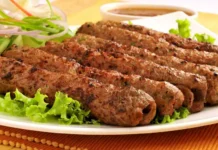[wzslider autoplay=”true” lightbox=”true”]
Revisit and relish the historic cuisines from the Colonial Raj era at the Anglo Indian Food Festival at The Bengaluru Brasserie in Hyatt Centric MG Road Bangalore. Guest Chef Bridget White Kumar, a renowned author, consultant and expert in Anglo Indian Cuisine has curated a special Anglo Indian menu for à la carte lunches and dinner buffets from 22nd February to 3rd March. The special dishes from this festival include authentic Anglo Indian cuisines like Railway Mutton Curry, The Dak Bungalow Curry, Grandma’s Country Captain Chicken, Potato Chops, Colonel Standhurst’s Beef Curry, Pork Country Captain, Bengal lancer’s Shrimp Curry, Pork Bhooni, Meat Jal Frezie, Devil Pork Curry, etc.
It could be rightly said that Anglo-Indian Cuisine was perhaps the first example of Fusion Food in India. Many of the dishes have a unique history behind their existence. There is a certain glamour about Anglo-Indian cuisine with its quaint names like Railway Lamb or Mutton Curry, The Dak Bungalow Curry, Grandma’s Country Captain Chicken, Colonel Standhurst’s Beef Curry, Pork Country Captain, Bengal lancer’s Shrimp Curry, Pork Bhooni, Chicken / Meat Jal Frezie, Devil Pork Curry, Potato Chops, Double Onions Meat Curry (Do Piaza), Meat Glazzie / Glassey (Fruity meat curry) and others.
The Railway Lamb / Mutton Curry is a direct throwback to the days of the British Raj, when traveling by train was considered aristocratic. The very name ‘Railway Lamb Curry conjures up scenes of leisurely travel by train in the early 1900s, of tables covered with snow white table cloths laid with gleaming china and cutlery, of turbaned waiters and bearers serving this tasty slightly tangy Curry dish with Rolls and Crusty White Bread in Railway Dining and Refreshment Rooms and in Pantry Cars on long distance trains. The Railway catering staff comprised of butlers, cooks and bearers who were all trained in the art of hospitality by the British. They were courteous and attentive and smartly dressed in White uniforms, ever solicitous to the needs of the traveling upper class public. All refreshments and food were served in the right dishes and each table in the dining car was laid with the right crockery, cutlery and napkins or serviettes all embossed with the British Indian Railway Monogram. As its very name suggests, this very popular and tasty dish was prepared and served in Railway Refreshment Rooms and only in First Class Pantry Cars on long distance trains, with Bread or Dinner Rolls. The curry was not too spicy keeping in mind the delicate palates of the British. It was prepared with tender pieces of lamb or mutton, potatoes and other Indian condiments along with the addition of either vinegar, tamarind juice or yogurt. The curry was not too pungent keeping in mind the delicate palates of the British. It was also popular with the Railway staff who had to be on duty for long periods at a stretch. The vinegar or Tamarind juice used in its preparation ensured that the curry would last for quite a few days and was an ideal accompaniment with rice as well.
Grandma’s Country Captain Chicken was a very popular dish during Colonial times since it was very easy to prepare. In those days, well-fed, homegrown country chickens were used in its preparation. The chickens were cooked together with fresh ingredients, for hours over a firewood oven to bring out its rich and delicious taste. This dish presumably got its name from an old Grandma who prepared this special dish for her favourite grandson, a Captain in the British Army! Another explanation is that this particular chicken dish was first prepared by a Captain on a Country Boat! Whatever the origins, it was a very popular and tasty dish that is still cooked even today in many Anglo-Indian Homes.
The Dak Bungalow Curry was a famous dish prepared by Khansamas or Cooks in Inspection or Dak Bungalows during the British Raj. It was prepared with either meat or chicken and served with rice and vegetables or bread to the British Officers when they stayed at the various Dak Bungalows, while on official trips around the country. The recipe for preparing this dish varied with each cook at the Dak Bungalows depending on the availability of ingredients in a particular place during the Colonial period. It’s a well-known fact that the Englishmen were quite fed up of their own bland cuisine and were always eager to sample the food cooked with Indian spices by the cooks in the various Inspection Bungalows.
The Dak Bungalow menu in the early days usually consisted of goat meat or chicken (country fowls), either roasted or grilled or made into a curry, invariably served with roasted potatoes, grilled tomatoes, rice kedgeree, or boiled eggs or omlettes and steamed vegetables. Since these Bungalows were situated on the main Trunk Roads with no markets or grocery shops in the vicinity, the cooks stationed at these Bungalows had to be innovative and use whatever ingredients were locally available. The Dak Bungalow recipes were therefore based more on the whims and imagination of the ‘bawarchi’ or cook. The cook had to work with the primitive equipments and there was not much he could do in the circumstances.
However, as time went on, each new generation of Dak Bungalow cooks was able to obtain the recipes of the dishes by word-of-mouth from their fathers and grandfathers. The new cooks or bawarchis were more versatile than their predecessors and quickly picked up other cuisines as well.
Mulligatawny Soup was actually the anglicized version of the Tamil “Melligu -Thani”. (“Melligu” meaning pepper and “Thani” meaning water). As the name suggests it was originally Pepper Water. However in course of time a lot of other ingredients such coconut, meat and other spices were added to give it a completely different flavour. The dish quickly became popular throughout the colonies of the Common Wealth. The Mulligatawny Soup of today bears little resemblance to the original ‘MELLIGU –THANI’ or our very own Anglo-Indian Pepperwater!
This cuisine still flourishes in parts of India and in parts of Britain, Europe, Australia and Canada where nostalgic memories of the Raj still linger on in the form of the Anglo-Indian Community. Anglo-Indian food is therefore the delicious result of the Colonial Raj in India. Anglo-Indians are very passionate about their food. They are basically Non-vegetarians. They are lovers of red meat, so Beef, pork, mutton / lamb are used extensively in their cuisine and feature as part of their main dishes every day. Vindaloos and Curries are prepared with meat and chicken. Ox Tail Vindaloo, Ox Tongue Vindaloo, Stews, Buffards, Trotters in gravy, etc are all favourite and popular Anglo-Indian dishes. Turkey Roast, Duck and Chicken Roasts, with stuffing are festive favourites and no Christmas, Easter, Birthday or First Communion Dinner would be complete without these delicacies. However, Beef Roast and Pork Roast are all time favourites and are prepared practically every week in an Anglo-Indian home.
A typical Anglo-Indian Sunday Lunch consists of Yellow Coconut Rice, Mince Ball (Kofta) Curry or ‘Bad Word Curry’ and Devil Chutney. The Saffron or Yellow Coconut Rice was always prepared with freshly squeezed coconut milk and butter in the olden days which has been now replaced with ready coconut milk from a tetra pack. The raw rice and coconut milk would be simmered with ghee or butter, saffron or turmeric, bay leaves and a few whole spices of cinnamon, cardamom and cloves till the rice was cooked perfectly. This delightful fragrant Rice preparation formed the perfect mild subtle base for a Special Anglo-Indian Meal.
The Meat Ball Curry was also known as Bad Word Curry as the word ‘Ball’ was considered a bad or slang word in the olden days. The older generation refrained from using slang words. Minced beef or lamb was used to prepare this delightful dish where the meat balls or koftas were simmered in a delicious, lightly spiced creamy coconut-based gravy. The Yellow Coconut Rice and Ball Curry were always accompanied by a typical Anglo-Indian Sauce or Relish known as Devil Chutney. Devil Chutney is a fiery red chutney or sauce. Its bright red colour often misleads people to think that is a very pungent and spicy dish. It is actually a sweet and sour sauce, and only slightly pungent. The vinegar and sugar used in its preparation react with the onion and red chilli to produce the bright red colour. Devil Chutney is also known as “Hell fire or Hell’s flame chutney or Fiery Mother-in-law’s Tongue Chutney” due to its vivid colour.
These were the signature Anglo-Indian Dishes, besides a variety of Pulaus, Dry dishes such as Pepper Fry made with either beef, pork, chicken etc. Chillie or Devil Fries, Crumbed Chops, Brinjal Bake or Eggplant Bake, Chicken and Duck Vindaloo, Fish Moilee, Fried Fish, Prawn fry, Chicken Pepper Fry, Beef Fry, potato chops, Croquettes, Cutlets, Rissoles, etc. are also popular Anglo-Indian Dishes. There are many varieties of Anglo-Indian Pickles and relishes uch as Brinjal Pickle, Salt fish pickle, lime and mango pickle, Apple Chutney, Sweet Mango Chutney, etc. These pickles tickled the palate and added zing to the food. They compliment the different rissoles and Potato Chops.
However, due to the influences of various factors, Colonial Cuisine is slowly getting extinct. Many of the old traditional Colonial dishes are not prepared these days and the recipes of many of them have died with the older generation who cooked with intuition and memory rather than a written recipe. It has therefore become imperative to preserve those very authentic tastes and flavours and record for future generations the unique heritage of the pioneers of this cuisine.
With this in mind Bridget White-Kumar has brought out Recipe Books on exclusive Anglo-Indian Cuisine. This collection of recipes is compiled with the intention of reviving the old tastes of the Colonial Era, and thereby preserving the old Flavours and tastes. The easy-to-follow directions make cooking these old, popular, sumptuous dishes simple, enjoyable and problem-free.
Bridget White-Kumar was born and brought up in Kolar Gold Fields, a small mining town in the erstwhile Mysore State which is now known as Karnataka. KGF was famous for its Colonial ambiance. She comes from a well-known Anglo-Indian family who lived and worked in KGF for many generations. After taking voluntary retirement from Canara Bank, Bridget found time to pursue her hobbies of cooking and writing. Cooking has always been her strong fort and as a hobby she would try out different recipes. Her mother and grandmother had quite a lot of old traditional Anglo-Indian recipes written on bits and pieces of paper. These recipes just had the basic ingredients written down with no proper measurements or quantities. If the quantities were mentioned they were in the old metric system of Pavs and handfuls which was quite confusing. Bridget started experimenting with all the old recipes and through trial and error she arrived at the exact quantities to be used and also substituted some of the dry ingredients with present day readymade powders, condiments, etc that are easily available, besides making the cooking process much simpler. This gave her an idea to record all her efforts in a manuscript and get them published so that others too could benefit from her efforts. In these days of fast foods and instant mixes, many people do not find the time to cook even a simple meal every day, (leave alone the old traditional dishes) while many others do not know how to prepare them. Moreover, in a world fast turning into a Global Village, with many Anglo-Indians migrating away from India and the younger generation not showing interest in old traditional food, she felt that it had therefore become imperative to preserve those very authentic tastes and flavours and record for future generations the unique heritage of the pioneers of Anglo-Indian cuisine. These Recipe Books are her small way of preserving the culture of the community through its culinary delights, thereby preserving its culinary heritage. Many of the dishes featured in her Recipe books that were prepared by the older generation are now almost forgotten. Moreover these old traditional recipes are not found in any other typical Indian Cookery Book. Her area of expertise is in Colonial Anglo-Indian Food and she gone through a lot of effort in reviving the old forgotten dishes of the Colonial British Raj Era. One of my Cookery books was selected as the Best Culinary History Book from India by Gourmand World Cook Book Awards 2012.
Chef Manish Uniyal, comes with over 18 years of experience in professional cooking and kitchen management. His professionalism, exemplary leadership qualities and thorough hands-on management of his staff have helped him don the chef’s toque for multiple 5-star properties across the country, including Taj, Hilton, Hyatt, Leela, etc. His keen understanding of the consumer palette,along with his ability to translate the same in his cuisines has also given him opportunities toshoulder crucial responsibilities like new property launches. Backed by a consistent, verifiable record of achievement and a mastery over the nuances of fine dining & gourmet cuisines, Chef Manish Uniyal is currently the Head Chef at Hyatt Centric MG Road Bangalore. Chef Manish attributes his deep-rooted fundamentals of kitchen management to one of his former mentors, Chef Vijay Nagpal and believes that the success of any property rides on an effective amalgamation of the core team’sstrengths and values. Chef Manish highly encourages consumer feedback and also claims them to be the inspiration behind most of his signature culinary flavours and menus so far. Both Chef Manish Uniyal and Bridget White Kumar have done magic to each of these dishes that are prepared and served so lovingly by the culinary team of Hyatt Centric.
Where– The Bengaluru Brasserie, Hyatt Centric Bangalore, 1/1 Swami Vivekanada Road, Next to MG Road, Ulsoor.
When – 23rd February 2019 to 3rd March 2019, Time – Lunch: 12:30pm to 3:00pm, Dinner: 8:30pm to 11:00pm
Wallet Factor – Lunch (à la carte): INR 999 plus taxes and Dinner (buffet): INR 1500 plus taxes.






 Raashii Khanna
Raashii Khanna










